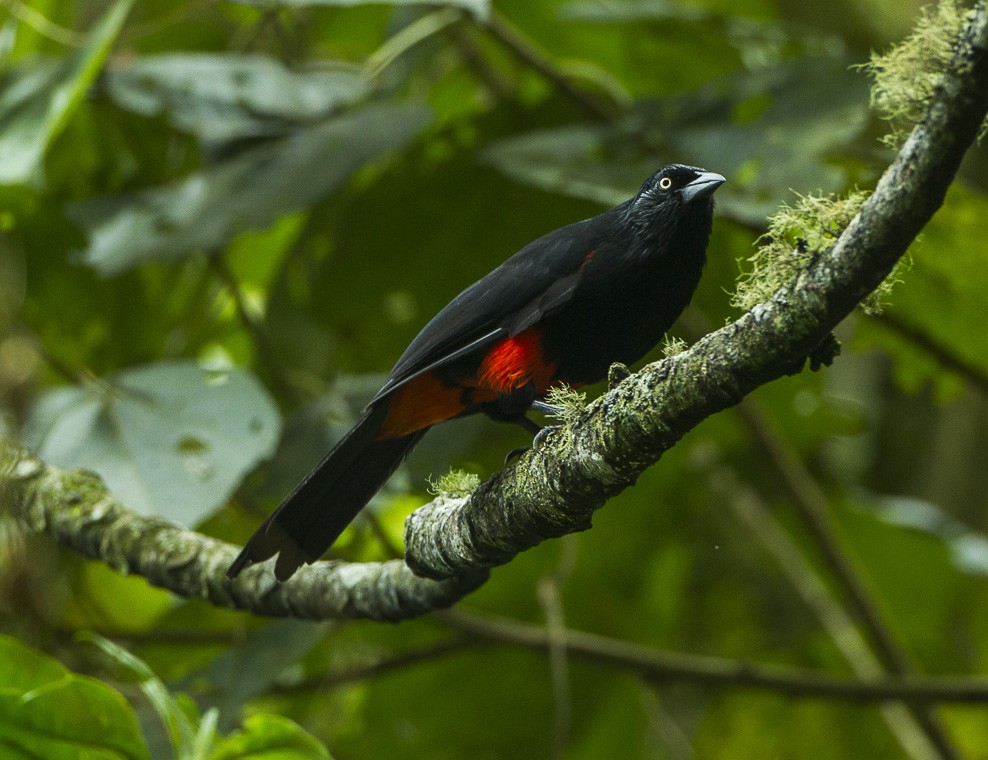Red-bellied Grackle
A species of Red-bellied Grackle Scientific name : Hypopyrrhus pyrohypogaster Genus : Red-bellied Grackle
Red-bellied Grackle, A species of Red-bellied Grackle
Botanical name: Hypopyrrhus pyrohypogaster
Genus: Red-bellied Grackle
Content
Description General Info
 Photo By Francesco Veronesi , used under CC-BY-SA-2.0 /Cropped and compressed from original
Photo By Francesco Veronesi , used under CC-BY-SA-2.0 /Cropped and compressed from original Description
The male red-bellied grackle grows to about 30 cm (12 in) and the female about 27 cm (10.6 in). The sexes are similar in appearance being entirely black apart from a red belly and red under-tail coverts. The bill is conical in shape and the irises are white or yellow. When held in the hand it is possible to see that the feathers of the head, neck and throat have shiny, naked shafts and thick, narrow webs. 
Size
31 cm
Nest Placement
Cavity
Feeding Habits
Red-bellied Grackle is an omnivorous bird, feeding on arillate fruits, berries, figs, and, occasionally, bamboo seeds. Their insect diet includes spiders, orthopteroids, and caterpillars, especially for nestlings. They forage primarily in canopy flocks, sometimes joining mixed-species groups.
Habitat
Red-bellied Grackle inhabits montane forests, preferring higher elevations typically above 1200 meters. Their habitat spans primary to secondary forests, forest edges, and nearby pastures and plantations. Although adapted to a range of disturbances, red-bellied Grackle thrives in areas between 800 and 2750 meters elevation, including altered landscapes such as scrublands and roadside areas.
Dite type
Frugivorous
General Info
Feeding Habits
Bird food type

Fruit
Behavior
Except during the breeding season, the red-bellied grackle is usually seen in small, noisy groups in the canopy. Sometimes these are mixed flocks with other grackles, and sometimes they may include Oropendolas. The grackles feed on fruit and insects, scrambling about among the branches and foliage, and sometimes clinging upside down. Breeding takes place between March and August. The nest is a cup-shaped structure in the fork of a tree, loosely composed of sticks and dead leaves. The eggs are greenish-grey, blotched and streaked with dark brown and lilac. The giant cowbird (Molothrus oryzivorus) sometimes lays its eggs in the grackle's nest. 
Distribution Area
The red-bellied grackle is endemic to Colombia where it is found in all three Andean ranges at altitudes of 800 to 2,400 m (2,600 to 7,900 ft) above sea level. Its natural habitat is tropical forest, but the trees are increasingly being felled for timber and to make way for agriculture, and little virgin forest remains within its range. However, it can tolerate some disturbance and can be seen at forest edges, in plantations, on cleared land, in scrub, over pasture and beside roads. 
Species Status
VULNERABLE. Restricted-range species: present in Colombian Inter-Andean slopes EBA and Chocó EBA.
Scientific Classification
Phylum
Chordates Class
Birds Order
Perching birds Genus
Red-bellied Grackle Species
Red-bellied Grackle